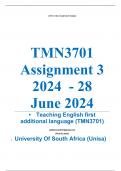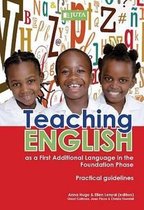[TYPE THE COMPANY NAME]
TMN3701
Assignment 3
2024 - 28
June 2024
• Teaching English first
additional language (TMN3701)
tabbymwesh59@gmail.com
[Pick the date]
University Of South Africa (Unisa)
,[Type the abstract of the document here. The abstract is typically a short summary of the contents of
the document. Type the abstract of the document here. The abstract is typically a short summary of
the contents of the document.]
, Exam (elaborations)
TMN3701 Assignment 3 (COMPLETE ANSWERS) 2024
(781296) - 28 June 2024
Course
Teaching English first additional language (TMN3701)
Institution
University Of South Africa (Unisa)
Book
Teaching English as a first additional language
TMN3701 Assignment 3 (COMPLETE ANSWERS) 2024 (781296) - 28 June
2024; 100% TRUSTED workings, explanations and solutions. .........
QUESTION 1 1.1 Explain the significant role of input, interaction and output in
the context of additional language teaching. Provide examples to support your
answer. (10)
In the context of additional language teaching, input, interaction, and output play crucial roles in
facilitating language acquisition and development among learners.
1. Input: Input refers to the language that learners are exposed to, either through listening
or reading. It serves as the linguistic data that learners need to process in order to
internalize the structures and patterns of the language. Input should be comprehensible
and appropriately challenging for learners at their proficiency level. For example, in a
language classroom, a teacher might provide input through spoken instructions, reading
passages, or multimedia resources tailored to the learners' language level. By receiving
comprehensible input, learners can begin to understand and internalize the language rules
and vocabulary.
2. Interaction: Interaction involves the meaningful exchange of language between learners
and others, such as peers or teachers. It provides opportunities for learners to practice
using the language receptively (listening and reading) and productively (speaking and
writing). Interaction promotes language fluency and accuracy as learners negotiate
meaning, clarify understanding, and receive feedback on their language use. For instance,
pair or group activities in a language class where students discuss a topic, solve a
problem, or role-play a scenario provide rich opportunities for interaction. These





